Primordial Evolution Game/Ocean: Difference between revisions
1d4chan>NO TRIP FOR THE HIVE |
m (50 revisions imported) |
||
| (3 intermediate revisions by 3 users not shown) | |||
| Line 272: | Line 272: | ||
They descended deep into the Ocean, lost their pigmentation, and heightened their awareness. By manipulating the sodium intake in their improved nervous system, they gain some bio-electric capabilities. Its bio-electrical capabilities expanded with its growing nervous system. And its perception expands to the visual spectrum. Its intellect evolved to establish rudimentary schooling orders. They lit up in flickering swarms and overcame larger prey in an electrocution frenzy before ravenously devouring it. | They descended deep into the Ocean, lost their pigmentation, and heightened their awareness. By manipulating the sodium intake in their improved nervous system, they gain some bio-electric capabilities. Its bio-electrical capabilities expanded with its growing nervous system. And its perception expands to the visual spectrum. Its intellect evolved to establish rudimentary schooling orders. They lit up in flickering swarms and overcame larger prey in an electrocution frenzy before ravenously devouring it. | ||
| Line 284: | Line 283: | ||
The Paddleworem made its return to the surface. Its pigmentation remained pale. Its row of eyespots atrophied and was replaced by an assortment of simple eyes located around its primaries. They lost their schooling trait in favor of mating pairs that actively watch over nests laying their egg clutches in reefs. Their rear sensors developed manipulators to traverse on the sea floor and beach shallows, saving energy and increasing their lifespan. Their need to breathe through moist skin limited them. | The Paddleworem made its return to the surface. Its pigmentation remained pale. Its row of eyespots atrophied and was replaced by an assortment of simple eyes located around its primaries. They lost their schooling trait in favor of mating pairs that actively watch over nests laying their egg clutches in reefs. Their rear sensors developed manipulators to traverse on the sea floor and beach shallows, saving energy and increasing their lifespan. Their need to breathe through moist skin limited them. | ||
===Paddlefrowg=== | ===Paddlefrowg=== | ||
| Line 374: | Line 376: | ||
<br />Status: <span style="color:#008000">'''Extant'''</span> or <span style="color:#FF0000">'''Extinct'''</span> | <br />Status: <span style="color:#008000">'''Extant'''</span> or <span style="color:#FF0000">'''Extinct'''</span> | ||
<br />Progenitor: Centiworem | <br />Progenitor: Centiworem | ||
<br />-> ]] | <br />-> Jet Bladeworem]] | ||
Bolstered by its new lifestyle as a swift-swimming predator and growing in size, the Centiworem developed a more efficient means of securing prey. With the various breeds of Fus becoming more resilient to attack, the Centiworem relied on their superior speed. Its fore-claws developed into bony cutting blades useful in hit-and-run. Bladeworem weakened their prey by striking them repeatedly before killing them with their powerful jaws. The Bladeworem changed their pigmentation to better suit their lives above the ocean floor. Their eyes fused into a set of compound eyes, and their inner-mandibles became better at tearing meat. Their natural fluids lost their adhesive properties becoming more caustic. | Bolstered by its new lifestyle as a swift-swimming predator and growing in size, the Centiworem developed a more efficient means of securing prey. With the various breeds of Fus becoming more resilient to attack, the Centiworem relied on their superior speed. Its fore-claws developed into bony cutting blades useful in hit-and-run. Bladeworem weakened their prey by striking them repeatedly before killing them with their powerful jaws. The Bladeworem changed their pigmentation to better suit their lives above the ocean floor. Their eyes fused into a set of compound eyes, and their inner-mandibles became better at tearing meat. Their natural fluids lost their adhesive properties becoming more caustic. | ||
===Jet | ===Jet Bladeworem=== | ||
[[Image:1332659242690.png|thumb|100px|right|upright| | [[Image:1332659242690.png|thumb|100px|right|upright| | ||
<br />'''Jet | <br />'''Jet Bladeworem''' | ||
<br />Status: | <br />Status: <span style="color:#FF0000">'''Extinct'''</span> | ||
<br />Progenitor: Blade Worem | <br />Progenitor: Blade Worem | ||
<br />-> ]] | <br />-> Pincerjaw Bladeworem]] | ||
As the Bladeworem became increasingly active, their quick reflexes removed the need for a back-facing defense mechanism. Their aft-pincers became vestigial. The Bladeworem developed a water propulsion system that runs the length of its sinuous body, affording it a degree of speed and maneuverability through the water heretofore unseen. This worked by channeling water through gaps in their carapace. Their aft-ends lost their aft-flippers and the glands to produce the caustic-solution | As the Bladeworem became increasingly active, their quick reflexes removed the need for a back-facing defense mechanism. Their aft-pincers became vestigial. The Bladeworem developed a water propulsion system that runs the length of its sinuous body, affording it a degree of speed and maneuverability through the water heretofore unseen. This worked by channeling water through gaps in their carapace. Their aft-ends lost their aft-flippers and the glands to produce the caustic-solution. | ||
=== | ===Pincerjaw Bladeworem=== | ||
[[Image:evonull.PNG|thumb|100px|left|upright| | [[Image:evonull.PNG|thumb|100px|left|upright| | ||
<br />'''Pincerjaw Bladeworem''' | |||
<br />Status: <span style="color:#FF0000">'''Extinct'''</span> | |||
<br />Progenitor: Blade Worem | |||
<br />-> Spitter Bladeworem]] | |||
Their once-mighty pincers shrank, and now spray caustic fluids into the surrounding water to wound and confuse closely-clustered schools of prey. | |||
From a higher reliance on their acid, they made less and less use of their limbs in hunting. Eventually they atrophied into movable spines along their carapace. Their propulsion was strong enough to launch them a short distance out of the water when hunting. | |||
===Spitter Bladeworem=== | |||
[[Image:evonull.PNG|thumb|100px|right|upright| | |||
<br />'''Blade Worem''' | <br />'''Blade Worem''' | ||
<br />Status: | <br />Status: <span style="color:#FF0000">'''Extinct'''</span> | ||
<br />Progenitor: Jet Slier | <br />Progenitor: Jet Slier | ||
<br />-> ]] | <br />-> Common Slizer]] | ||
The Bladeworem's jaw and mandibles fused into a single gaping maw, its acid glands | The Bladeworem's jaw and mandibles fused into a single gaping maw, its acid glands shifted into the interior of its mouth. The primary set of eyes shifted to the side while a new set developed in their place, allowing it a greater field of view for catching sight of prey both above and below. | ||
The Bladeworem's uppermost blades lost their sheer bony ridge, developing into fins that allowed it to glide briefly above the water. It compensated for the lost by growing more spines and blades. | |||
Another set of gliding-wings grew towards their aft-ends, and their tough carapace began to loosen into a more flexible array of plating. | |||
===Common Slizer=== | |||
[[Image:evonull.PNG|thumb|100px|left|upright| | |||
<br />'''Common Slizer''' | |||
<br />Status: <span style="color:#008000">'''Extant'''</span> or <span style="color:#FF0000">'''Extinct'''</span> | |||
<br />Progenitor: Blade Worem | |||
<br />-> Land Slizer | |||
<br />-> awaiting reef slizers]] | |||
The Bladeworem's jaw split into four iron-hard, tooth-filled beaks. The caustic spray begins to regain some of its adhesive qualities, allowing it to bind or weigh-down flying prey before jetting in for the kill. | |||
==Fus Evolution== | ==Fus Evolution== | ||
Latest revision as of 10:06, 22 June 2023
Primordial Ocean[edit]
This page details the events of the first part of the Primordial Evolution Game
Major Events[edit]
Volcanic Activity
Volcanic activity has caused some upheaval! It causes mass deaths, although in the aftermath, more nutrients cause more algae and moss to flourish.
Oxygen Increase
Another event occurs! Due to the algae boom, oxygen is now more dominant in the environment! This means the creatures now can increase in size previously unheard of, as well as increased muscle growth! In an unrelated news, some of the moss had made it above the water. Yes, there's now surface plants. This doesn't affect the creatures much, though, since there's still a lot of space in the ocean... for now.
Progenitors[edit]

Sluck
Slow-moving bottom-dweller which eats primitive moss and detritus. The Sluck creature evolved to avoid predators and improve locomotion around the ocean floor. The Sluck first manifested an odd pigment which resembles a smiley face on its tail in hope that future predators would only eat that non-vital portion of the creature. They mutated a membrane sack on their backs in order to float over the ocean floor and predators. They then developed a slight membrane on the sides of their bodies which they flap to help them maneuver. As they float more, the Sluck developed a crude dorsal fin and began to eat the pieces of less fortunate Sluck. The last mutation was a pair of light sensitive organs to avoid fus.
Worem
Slightly faster bottom-dweller which sometimes dig into the substrate. Eats detritus and substrate. Segmented. The first mutation in this species was to develop a pair of feathered scoopers for better sifting through the substrate for delicious nutrients.
Fus
A slow-swimming jellyfish that eats plankton. The first mutation in this species was to grow two fins and an elongated flagella-like tentacle for better movement.
Sluck Evolution[edit]

Bloat Sluck[edit]
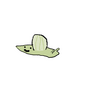
Bloat Sluck
Status: Extinct
Progenitor: Sluck
-> Finned Sluck
These sluck had a membrane sack on their backs that enabled them to float above the seafloor. While floating, they were at the mercy of the ocean currents.
Finned Sluck[edit]

Finned Sluck
Status: Extinct
Progenitor: Previous
-> Armor Sluck
-> Buoyant Sluck
-> Shwirm
Flaps alongside the body of the Finned Sluck allowed it to propel itself against through its aquatic environment. Their diet began to include meat, as they'd take small bits of other animals they'd pass by. Having rudimentary eye sight allowed them to identify predators and prey.
Armor Sluck[edit]

Armor Sluck
Status: Extinct
Progenitor: Finned Sluck
-> Mandible Sluck
After generations of being preyed on, the most active Sluck developed armored shells to ward off stings and bites. The limp membranes along the side of its body became more robust and braced with bony spurs. This facilitated greater control in its locomotion. The rear end developed into a powerful fin increasing the creature's mobility.
Mandible Sluck[edit]

Mandible Sluck
Status: Extinct
Progenitor: Armor Sluck
-> Land Sluck
After hardening the species' defenses, the creatures mutation turned offensive. The first mutation of this form was to develop offensive mandibles that bite through other species' armor. The next change was bony armor protrusions. The protrusions were used for attacking and walking on the surface floor. Over the next generations, the bony protrusions became more articulated and provide more locomotion until they break the surface of the ocean. They often clash with Blade Worem.
Land Sluck[edit]

Land Sluck
Status: Extinct
Progenitor: Previous
-> Stalk
The Sluck that have arrived on land slighted evolved. The side membranes atrophied. They became a part of the slucks armoring. Finally its air sac has receded into its body. However, no armor has developed over it, leaving a vital weak point. They are frequently in competition with Shield Worems and Colonyfus.
Buoyant Sluck[edit]

Buoyant Sluck
Status: Extinct
Progenitor: Finned Sluck
-> Harpoon Sluck
-> Jet Sluck
-> Nuro
The Sluck that did not develop hard shell, instead grew a tough hide that is strong but flexible. They inflated themselves to increase their buoyancy and floating ability. They also grew pelvic fins.
Jet Sluck[edit]

Jet Sluck
Status: Extant
Progenitor: Previous
The Jet Sluck has multiple openings along its body leading to the puffer chamber. They contract muscles and direct water out through the openings for a boost of speed.
Harpoon Sluck[edit]

Harpoon Sluck
Status: Extant or Extinct
Progenitor: Previous
-> Lancer Sluck
As they began to float towards the water's surface, they began to develop the beginning stages of aerobic respiration, as well as two harpoon tentacles which fire at prey below. These Slucks break the surface and bring their prey above water to suffocate them.
Lancer Sluck[edit]

Lancer Sluck
Status:Extinct
Progenitor: Previous
-> Lurking Sluck
Slucks reproductive cycle changed becoming plant-like, females released spores which land on males feeding off of them like parasites until they mature. The next evolution greatly improved its harpoons and made an extremely acidic enzyme. These harpoons now sucked out the inside of prey and liquefied it with the acidic enzyme. The enzyme could also be secreted from the Sluck's skin as a defense mechanism. The Sluck reproductive cycle changes again. Females had a third harpoon used to implant Sluck spores in a living host body. The spores grow inside the host and devour its organs, bursting from the body when fully mature.
Lurking Sluck[edit]
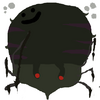
Lurking Sluck
Status: Extant
Progenitor: Lancer Sluck
-> Black Sluck
-> Crub
Lurking airborne sluck trawls the ocean at any depth. Sharp eyes on long stalks provide precise vision. The creatures cluster of harpooons are able to extend far below it's body. The harpoons are sensitive to electric activity, and can be used as sensors as well as weapons. Spores cling to it's thick hide, suspended in thick poisonous goo.
Black Sluck[edit]

Black Sluck
Status: Extinct
Progenitor: Lurking Sluck
-> Wesck
-> Dragon Sluck
-> Adoni
The Lurking Sluck changed its appearance radically from its progenitor. It became round and black surrounded by thick poisonous goo with spores clinging to its hide. These Slucks become airborne. This mutation also saw an increase in its awareness of its environment. It developed eyes on its stalks to provide precise vision, and its harpoons became electrically sensitive which it used as sensors as well as weapons. The reach of their harpoons increased as well, allowing them to stab prey in the ocean and on land without descending. Due to lack of predators and high population the Airborne Sluck's brain is developed at an increased rate organizing themselves into small groups. In the last mutation, their bodies elongated to provide room for more harpoons and internal organs.
Long Sluck[edit]

Long Sluck
Status: Extinct
Progenitor: Previous
-> Dragon Sluck
-> Wasp Sluck
-> Fluz
The Long Slucks elongated bodies provide room for more harpoons and internal organs
Dragon Sluck[edit]

Dragon Sluck
Status: Extant
Progenitor: Long Sluck
The Dragon Sluck lost most of its harpoons and instead but grew larger. The enzyme secreting glands moved from the creature's skin to the stomach to facilitate digestion. The brain size decreased. And finally, the Dragon Sluck started laying eggs removing the need for the spore sac harpoon.
Wasp Sluck[edit]

Wasp Sluck
Status: Extinct
Progenitor: Long Sluck
-> Wesck
And the Wasp Sluck evolving from AirBorne Sluck spores placed within prey to adapt to the increasing number of prey and predators on land, they no loger excrete their toxic enzyme but still contain it for food digestion many of their legs have developed bones and become like legs, they no longer float like their AirBorne cousins but have developed large clear rounded wings, and a short stinger attached to their thorax, they have lost their social system but have developed a hive mind
Worem Evolution[edit]

Scooper Worem[edit]

Scooper Worem
Status: Extant
Progenitor: Worem
-> Flat Worem
-> Gut Worem
-> Foot Worem
-> Island Scooper Worem
The Scooper Worem got its name from the pair of feathery scoopers alongside their mouths, better sifting through the substrate for delicious nutrients.
Flatworem[edit]

Flatworem
Status: Extinct
Progenitor: Scooper Worem
-> Fold worem
-> Spindly Worem
A population of Worem became flat to better hide under the substrate. This allowed the Worem to slip through the rocky cracks. Later, they'd develop a similar gene expression to the Feet Worem. The resulting limbs allowed them to rapidly flee predators by swimming to the safety of rocky cracks. They also had eyespots running along their backs, helping the Flat Worem avoid predators.
Fold Worem[edit]

Fold Worem
Status: Extinct
Progenitor: Flatworem
-> Unshelled Flatworem
Some flatworems took to higher water, becoming more flexible and maneuverable above the surface of the sea floor. Their mouth shifted to the front of the body to filter out plankton they run across. The underbelly became lighter colored to blend in from above. They increased in size and evolved a series of light armored plates connected with tough but flexible tendons to protect themselves from predators.
Unshelled Foldworem[edit]

Unshelled Foldworem
Status: Extant
Progenitor: Fold Worem
-> Land Foldworem
-> Island Flatworem
With time, the foldworms returned to their roots. They lost their plated exoskeleton in favor of a sleeker, faster body, their undersides sporting a light blue color to blend with the surface when seen from underneath. Eventually, the slits alongside its head began to function as additional mouths rather than just water outlets for their filter feeding.
Spindly Worem[edit]
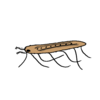
Spindly Worem
Status: Extinct
Progenitor: Flatworem
-> Paddle worem
Perhaps taking a cue from its cousin, the flatworem's leg-spines lengthen and become more flexible to allow it better swimming ability when it must flee for safety.
Paddle Worem[edit]

Paddle Worem
Status: Extinct
Progenitor: Spindly Worem
-> Deep Paddle Worem
The Paddle Worem evolved ululating fins and electro-magnetic antennae.
Deep Paddle Worem[edit]

Deep Paddle Worem
Status: Extant
-> Reef Paddle Worem
They descended deep into the Ocean, lost their pigmentation, and heightened their awareness. By manipulating the sodium intake in their improved nervous system, they gain some bio-electric capabilities. Its bio-electrical capabilities expanded with its growing nervous system. And its perception expands to the visual spectrum. Its intellect evolved to establish rudimentary schooling orders. They lit up in flickering swarms and overcame larger prey in an electrocution frenzy before ravenously devouring it.
Reef Paddle Worem[edit]

Reef Paddle Worem
Status: Extant
Progenitor: Reef Paddle Worem
-> Paddlefrowg
The Paddleworem made its return to the surface. Its pigmentation remained pale. Its row of eyespots atrophied and was replaced by an assortment of simple eyes located around its primaries. They lost their schooling trait in favor of mating pairs that actively watch over nests laying their egg clutches in reefs. Their rear sensors developed manipulators to traverse on the sea floor and beach shallows, saving energy and increasing their lifespan. Their need to breathe through moist skin limited them.
Paddlefrowg[edit]

Paddlefrowg
Status: Extinct
Progenitor: Reef Paddle Worem
-> Frowg
The paddleworem's returning trips to the shores allowed it to process oxygen from the air through its moist skin. In response its skin toughened as it traversed the prehistoric marshes and swamps bridging the pseudo-amphibian's way into terrestrial territories. Its constant pursuit by advancing air and landborne predators forced it to hide in muddy banks. Its lack of sodium deterred its bio-electric abilities. It retained its heightened senses, staying one step ahead of predators and prey as groups of frowgworems make harmonious chirps and clicks during breeding season.
A cartilaginous structure began the first steps into developing a genuine skeleton. Fully formed toes and red muscles fueled by an early single lung, (despite their dependance on absorbing oxygen through their skin still) develop as the paddlefrowg scuttles onto land into further inland water sources, spreading its influence far and wide. Airborne slucks compete with these landbound creatures and their wily maneuverability, maintaining a niche as one of the first genuine terrestrials, feeding on their woremy ancestors with controlled electric jolts from their roughly untouched forelimbs.
Gut Worem[edit]

Gut Worem
Status: Extinct
Progenitor: Scooper Worem
-> Shield Worem
Worem digestive tracts became more efficient at processing food. This caused a visible bulging in their lower body. Gut Worems grew larger to compensate for a more complex digestive system.
Shield Worem[edit]

Shield Worem
Status: Extinct
Progenitor: Gut Worem
-> Fast Shield Worem
Predation from footWorem created a new breed of gutWorem with chitinous plates along their top. When threatened, they curl into a ball. When faced with nutritious mosses they couldn't eat, just sucking algae off of, Shield Worem developed teeth to munch up dem leafy greens. Also, their little manipulator things become more sensitive and switch functions to become antennae, allowing them to sense the water flow around them.
Fast Shield Worem[edit]
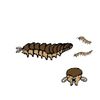
Fast Shield Worem
Status: Extant
Progenitor: Shield Worem
-> Protoglund
Faster Shield Worem are able to gobble down all the food before their bretheren get there. The soft underparts of some individuals become elongated and supple at their junctures, allowing for a rilling movement not unlike a centipede.
Many environmental pressures were negligible to Shield Worems. They had an immense population. They started their path with a boost for their digestion, came through survived widespread geological catastrophe almost unscathed, and their predators are too few to knock a serious dent in their population. This became the Shield Worem's greatest strength. Their next step takes this to another level: live birth and large litters. The old, slow-breeding Shield Worem can't keep up and die off. Predators can't make a dent in the overall population. Also, their little leggy things separated into two legs instead of one rill.
Protoglund[edit]
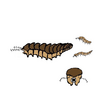
Protoglund
Status: Extinct
Progenitor: Fast Shield Worem
-> Glund
The surface-dwelling Shield Worems, precursors to proper Glunds, developed primitive lungs to help them survive longer on out of water and get dem tasty greens. As a result it became a bit larger. It's feelers became more feathery and lighter to move in the air, and its jaws shifted slightly to help it chew these tougher plants.
Leg Worem[edit]

Leg Worem
Status: Extinct
Progenitor: Scooper Worem
-> Leg Worem
The Worem began to develop a series of crude limbs, allowing it to scuttle or swim even faster along the ocean floor. This enhanced locomotive capability, combined with primitive eyes allowed it to take a more active role in the food chain. Their legs would develop further, allowing them tremendous speed on the ocean floor at the cost of slightly diminishing swimming capability. Their scoops also secreted a sticky resin that attracted plankton to its waiting maw. For a time, these worems also employed the use of luminescent spots on their scoops to attract the attention of larger prey. At the animals rear was a stinger for use in deterring predators, and possible attacks from larger Leg Worem.
Pincer Worem[edit]

Pincer Worem
Status: Extinct
Progenitor: Leg Worem
-> Bladeworem
-> Skrimp
-> Schwar
The forelimbs of the Pincer worem were dextrous claws for latching onto wandering prey, and its tail was the namesake pincer. The tail pincer had a gland which would produce a sticky resin. Combined with their simple eyes, the Pincer worem was an effective predator in its time.
CentiWorem[edit]

Worem
Status: Extant or Extinct
Progenitor:
-> Blade Worem
With their newfound sensory organs, the Centiworem became more predatory. Their aft-limbs developed into flippers for swift propulsion, while their fore-limbs became more adept at grabbing onto prey. Translucent flaps sprouted from its carapace, and it developed two more sets of eyes for tracking prey. A series of volcanic eruptions wiped out a sizable amount of their population, by chance leaving some of the more ferocious specimens. Cannibalism would become a more common occurrence in the species. Their exoskeletons served mostly to protect them from each other. They no longer used light to draw their prey. Instead, their scoops developed into chitinous jaws and their mouth became more adept at chewing up meat. Its aft-flippers became larger increasing its swimming acceleration.
Blade Worem (A.K.A. Slizer)[edit]

Blade Worem
Status: Extant or Extinct
Progenitor: Centiworem
-> Jet Bladeworem
Bolstered by its new lifestyle as a swift-swimming predator and growing in size, the Centiworem developed a more efficient means of securing prey. With the various breeds of Fus becoming more resilient to attack, the Centiworem relied on their superior speed. Its fore-claws developed into bony cutting blades useful in hit-and-run. Bladeworem weakened their prey by striking them repeatedly before killing them with their powerful jaws. The Bladeworem changed their pigmentation to better suit their lives above the ocean floor. Their eyes fused into a set of compound eyes, and their inner-mandibles became better at tearing meat. Their natural fluids lost their adhesive properties becoming more caustic.
Jet Bladeworem[edit]

Jet Bladeworem
Status: Extinct
Progenitor: Blade Worem
-> Pincerjaw Bladeworem
As the Bladeworem became increasingly active, their quick reflexes removed the need for a back-facing defense mechanism. Their aft-pincers became vestigial. The Bladeworem developed a water propulsion system that runs the length of its sinuous body, affording it a degree of speed and maneuverability through the water heretofore unseen. This worked by channeling water through gaps in their carapace. Their aft-ends lost their aft-flippers and the glands to produce the caustic-solution.
Pincerjaw Bladeworem[edit]
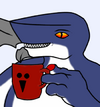
Pincerjaw Bladeworem
Status: Extinct
Progenitor: Blade Worem
-> Spitter Bladeworem
Their once-mighty pincers shrank, and now spray caustic fluids into the surrounding water to wound and confuse closely-clustered schools of prey. From a higher reliance on their acid, they made less and less use of their limbs in hunting. Eventually they atrophied into movable spines along their carapace. Their propulsion was strong enough to launch them a short distance out of the water when hunting.
Spitter Bladeworem[edit]

Blade Worem
Status: Extinct
Progenitor: Jet Slier
-> Common Slizer
The Bladeworem's jaw and mandibles fused into a single gaping maw, its acid glands shifted into the interior of its mouth. The primary set of eyes shifted to the side while a new set developed in their place, allowing it a greater field of view for catching sight of prey both above and below. The Bladeworem's uppermost blades lost their sheer bony ridge, developing into fins that allowed it to glide briefly above the water. It compensated for the lost by growing more spines and blades. Another set of gliding-wings grew towards their aft-ends, and their tough carapace began to loosen into a more flexible array of plating.
Common Slizer[edit]

Common Slizer
Status: Extant or Extinct
Progenitor: Blade Worem
-> Land Slizer
-> awaiting reef slizers
The Bladeworem's jaw split into four iron-hard, tooth-filled beaks. The caustic spray begins to regain some of its adhesive qualities, allowing it to bind or weigh-down flying prey before jetting in for the kill.
Fus Evolution[edit]
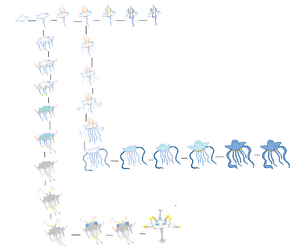
Sticky Fus progenitor: Fus
The fus evolved a series of sticky strands that float above them and collect plankton. They move a bit faster then their progenitor and get more nutrient input. Balloon Slucks got tangled in these new strands. As a result, the ocean became more detritus. These Fus developed an enzyme to break down the attacked flesh and gain the energy from captured creatures. The last mutation makes the feeding behavior more elaborate as a new set of tendrils that methodically scrapes bits of creatures down the enzyme strands and into its digestive system.
Colony Fus progenitor: Fus / deviation: Tentacle Colony Fus
Some Fus collected themselves together, acting as single organism. The colony covered more area and gathered more plankton. The Sticky Fus could still interbreed with the Colony Fus. As a result the population of lone Sticky Fus declined. The colony incorporated Sticky Fus as external members. The incorporated Fus grew sacs on the end of their flagella that stings and paralyses other organisms. Worems were quick to evade this, but the Slucks were often caught and digested. To catch Worems, the stingsacs developed bards that could shoot short distances. In response to the Foot Worems resin, the Colony Fus evolved a thicker membrane coating and small oil secreting glands to negate the resin. The last mutation before total pigment change was two long and strong transparent tentacles with flagella to grab Shield Worems, which they crush on the sea floor or throw far away.
Tentacle Colony Fus progenitor: Colony Fus / deviation: Pluup
The pigment of the Colony Fus tentacles starts to cover the entire body of the organism. Its membrane and flagella become transparent. Only its stingsacs and digestive strings remain visible. The Fus then grew two large movement sensitive antennae which continue to develop to use echolocation. To handle the extra input the Colony Fus brain developed further. When Colony Fus began to entangle in thick algae clouds, an offshoot developed weak acid that burned through the algae on contact. The acid irritated Fus membranes and disturbed their antennae. The Colony Fus developed two large gas filled sacs. They used them to travel quickly upwards, sometimes propelling them above the surface. The sacs continued to develop a protective membrane as well as a respiration tube to breathe directly from air.
Poison Fus progenitor: Sticky Fus / deviation: Floating Fus
Some Sticky Fus began to grew tendrils that secrete a rudimentary poison. These Fus use this poison to protect themselves from Worem threats, as well as to incapacitate prey. They then developed more specialized fins to propel themselves faster and more accurately. After the Volcanic Activity Event, the Poison Fus population decreased dramatically. As a result they started to prey upon all forms of life including the Colony Fus. The next mutation was a set of tendril limbs that they used to grasp onto prey and to anchor themselves when they rest. The last mutation before losing its poison tendrils, they developed more tendrils that grow stronger and longer.
Floating Fus progenitor: Poison Fus / deviation: Beached Floating Fus
The free floating fus, due to their predatory nature, no longer relied on the feeder tendrils of their progenitors. These were eliminated. The poisonous tendrils have receded and atrophied. They developed a thick, squishy protective membrane to protect their soft bodies. The membrane grew over its body, grabbing-tendrils, and locomotive-tendrils. Due to the increase in food, their grabbing-tendrils increased greatly in strength and length allowing for a much tighter grip. The Fus could coil and uncoil the locomotive-tendrils as it saw fit. The Floating Fus' navigational fins grew and strengthen, allowing Fus to propel them out of the water for short periods of time to escape from predators. They developed sacs filled with very light gases that allow the Fus to slowly float back to the water after they launch themselves into the air.
Beached Floating Fus progenitor: Floating Fus / deviation: Flouz
The Floating Fus occasionally breached themselves on land with their floating. They developed significantly stronger tendrils, now much more resembling tentacles than tendrils, to pull themselves across the land and back to the ocean. The membrane surrounding their body increased in thickness and strength, and allowed for greater protection, though was still very squishy, and allowed them to survive the brunt of land dwelling predators. The Flus' air sacs separated into two lobes, each increasing in size on the inside of the body. This allowed for significant longer sustained floating, as well as a decreased need to return to water. The increased space in between the air sacs allowed the Flus' mandibles to grow in size, and is now used more aggressively. The poison glands of old adapted into a thing coating of the poison along the Flus' body. This poison was alkaline in nature, and neutralized the Blade Worem's acid. Though it is immune to the Blade Worem's acid, the Flus' soft yet rubbery hide is not a very good defense against the Blade Worem's blades and teeth. This, combined with their slow floating speed, makes the Flus a major prey for the Blade Worem. These recent adaptations allowed the Flus to attack prey by dropping on top of it.
Abyss[edit]
Major Events[edit]
Abyss Progenitors[edit]
Crub
A small soft-shelled crab-like creature with a luminescent lure. Descended from Slucks.
Glub
A small species of Nuro.
Hem'Fur
A large Nuro species with fin positioning which made them difficult to eat.
Kwenom
An urchin-like bottom feeder. Descended from Worems.
Seekeed An aquatic plant.
Skrimp
A shrimp-like shelled worm. Surprisingly related to Slizers.
Ykex'ry
An eel-like creature related to Hem'Furs.